|
Program Manager
Polly A. Penhale
ppenhale@nsf.gov
(703) 292-8033
Marie Bundy
mbundy@nsf.gov
(703) 292-8033
See also
* LTER
Project
|
The Antarctic Biology and Medicine program supports
research leading to an improved understanding of physiology, behavior,
adaptations, and processes related to life forms and ecosystems in Antarctica.
Projects are directed at all levels of organization
from molecular, cellular, and organismal to communities, ecosystems,
and global processes. Investigators apply recent theory and technology
to understanding how organisms, including humans, adapt and live in high-latitude
environments and how ecosystems respond to global change. Support is
focused on the following areas:
- Marine ecosystem dynamics. Understanding
the natural variability of marine ecosystems is the goal. An important
direction is toward
correlating the structure and function of the marginal ice-zone ecosystem
with oceanic and atmospheric processes. Of particular interest is
the influence of nutrient limitations on primary production and the
role of marine phytoplankton in carbon dioxide cycling. Proposals
to develop data collection technologies, such as satellite remote
sensing, are encouraged.
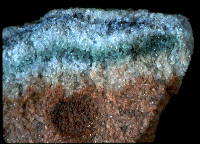
Right: Limestone containing microscopic life(blue band)
known as cryptoendolithic organisms.
- Terrestrial and limnetic ecosystems. Organisms in ice-free areas
and in perennially ice-covered lakes show remarkable adaptations.
The presence of relatively few species eases study of ecosystem dynamics
and interpretation of experiments. Research is needed on adaptive
mechanisms and evolutionary processes. Studies that include molecular
biological approaches are encouraged. The McMurdo Dry Valleys of
southern Victoria Land are of particular interest.
 |
- Population biology and physiological
ecology. Research is supported in population dynamics, especially
metabolic, physiological, and behavioral adaptations of krill
and other zooplankton and fish species. Marine mammals and birds
have been the object of much research and merit further attention
in some areas. Mechanisms necessary for maintenance of cell
function in fishes and their feeding behavior are important
Long-term observations are topic needed to improve understanding
of man made or natural changes.
Left: Antarctic Krill
|
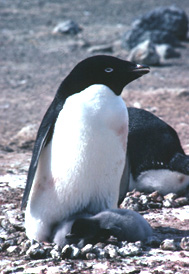
Right : Adelie penguin and chick.
- Adaptation. The extremes of light,
temperature, and moisture have resulted in unusual adaptations. Research
topics include low-temperature
photosynthesis and respiration, enzymatic adaptations, adaptive strategies
such as development of antifreeze compounds and modifications to
circulation systems, and the response of organisms to increased UV-B
from the ozone hole. Biotechnology offers unique approaches to addressing
questions involving adaptation, and such applications are of special
interest.
- Human behavior and medical research.
Antarctica's extreme climate can induce social, psychological, and
physiological stresses, particularly
during the winter isolation that can exceed 8 months. Research
has applications to human health and performance both in the Antarctic
and in other isolated environments such as spacecraft. Studies can
focus on topics such as epidemiology, thermal regulation, immune
system function, individual behavior, and group dynamics.
Long-term Ecological Research
(LTER)
The Antarctic Biology and Medicine Program supports two Long-Term Ecological
Research (LTER) Projects in Antarctica — one in the Palmer Station
Area of the Antarctic Peninsula and the other in the McMurdo Dry Valleys.
The
Long-Term Ecological Research (LTER) Program, supported by the
U.S. National Science Foundation, consists of a network of 24 ecosystem
research sites extending from Alaska to Puerto Rico. These represent
a variety of ecosystems types, including grassland, desert, forest,
tundra, lake, stream, river, agricultural, and coastal systems.
The LTER program in the United States was developed in the late 1970's,
when scientists recognized the need for long-term data sets to better
understand ecological phenomena that occur on the scale of years
to
decades to
centuries and the role of cyclical or episodic events in ecosystem
structure and function.
Five core research areas are addressed at each LTER site:
- pattern and control of primary production;
- spatial and temporal distribution of populations selected to represent
trophic structure;
- pattern and control of organic matter accumulation;
- pattern of inorganic inputs and movements of nutrients through
the ecosystem; and
- pattern and frequency of disturbance, both natural and human-induced,
to the sites.
Each site within the LTER Network shares a common commitment to create
a legacy of well-designed and documented long-term field experiments
and observations to improve understanding
of basic properties of ecosystems, as well as factors causing widespread
changes in the world's ecosystem. Sites are also required to synthesize
research efforts among sites, such as response to natural and anthropogenic
disturbances, and to extrapolate from local scales to continental and
global scales. A goal of the LTER network as a whole is to gain insight
into Earth's ecosystems through comparative ecosystem studies.
The Palmer/Peninsula LTER
project
The U.S. Antarctic Program's commitment to long-term ecological research
in Antarctica was formalized through the designation of the Palmer Station
area of the Antarctic Peninsula as an LTER site in 1990. The
Palmer Station LTER research program began during the 1991-1992
season with the installation of an automatic meteorological station,
annual research cruises in the austral summer, and a focused research
program at Palmer Station. Process-study cruises are conducted
during the austral fall and spring, and comparisons are made with
other coastal systems in the Antarctic Peninsula.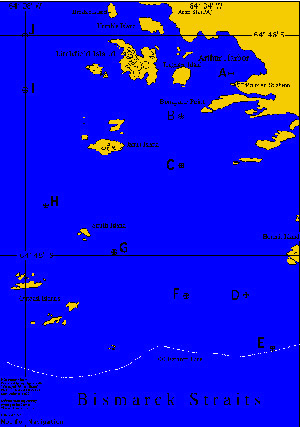
Right: Antarctic Peninsula/Palmer Station long-term ecological
research area.
The LTER program centered at Palmer Station focuses on ecological
processes that link the extent of annual pack ice to the biological
dynamics of different trophic levels within the antarctic marine community.
Research at Palmer Station and in the surrounding nearshore marine
environment focuses on seabirds (Adelie penguins and south polar skuas),
the prey of the seabirds (antarctic krill and antarctic silverfish),
primary production, and bio-optical and hydrographic characteristics
of the water column. Processes (such as reproduction and recruitment)
and parameters (such as food availability), which are sensitive to
environmental change, are monitored.
Research cruises extend the spatial scale beyond the Palmer Station
area and include sampling of prey distribution, abundance, and physiological
condition; primary production estimates; and water-column characteristics.
The data collected from the various spatial and temporal scales are
linked through modeling. A set of
five interfacing models are being developed. The models will simulate
processes occurring at one trophic level (bio-optical model of primary
production), processes occurring within one of the representative species
(krill population-swarm model and two seabird population dynamics models)
and processes occurring in the marine environment (regional ocean-ice
circulation).
The LTER program encourages collaborative efforts and ecosystem comparison.
Results from the Palmer Station Area LTER program and cooperative projects
further understanding of the impact of interannual variability in pack-ice
extent on the vitality of the marine food chain and allow for a separation
of long-term (decadal) system trends from interannual variablity
in populations. Comparisons of the Palmer Station Area LTER data with
data from other LTER sites and other large ecosystem projects will
further an understanding of ecosystem structure and function.
The McMurdo Dry Valleys LTER
project
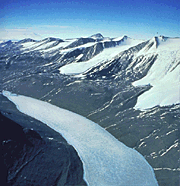 Only
2% of the Antarctica is ice-free; the McMurdo Dry Valleys is
the largest of these ice-free areas. These ice-free areas display a sharp
contrast to most other ecosystems, which exist under far
more moderate environmental conditions. The perennially
ice-covered lakes, ephemeral streams, and extensive areas of exposed
soil within the McMurdo Dry Valleys are subject to low temperatures,
limited
precipitation, and salt accumulation. Thus, the Dry Valleys represent
a region where life approaches its environmental limits and is an “end-member” in
the spectrum of environments included in the LTER Network. The Dry Valleys,
unlike most other ecosystems, are dominated by microorganisms, mosses,
lichens, and relatively few groups of invertebrates; higher forms of
life are virtually non-existent. Only
2% of the Antarctica is ice-free; the McMurdo Dry Valleys is
the largest of these ice-free areas. These ice-free areas display a sharp
contrast to most other ecosystems, which exist under far
more moderate environmental conditions. The perennially
ice-covered lakes, ephemeral streams, and extensive areas of exposed
soil within the McMurdo Dry Valleys are subject to low temperatures,
limited
precipitation, and salt accumulation. Thus, the Dry Valleys represent
a region where life approaches its environmental limits and is an “end-member” in
the spectrum of environments included in the LTER Network. The Dry Valleys,
unlike most other ecosystems, are dominated by microorganisms, mosses,
lichens, and relatively few groups of invertebrates; higher forms of
life are virtually non-existent.
The McMurdo
Dry Valleys LTER project is an interdisciplinary study of the
aquatic and terrestrial ecosystems in a cold desert region of Antarctica.
This research can only be carried out
in Antarctica because nowhere else on earth does there exist a terrestrial
environment
that is bereft of higher plants and animals and that is characterized
by such limited availability of water and nutrients and by such low
temperatures. Organisms, unique to Antarctica, in the Dry Valleys
have, over eons of evolution, developed mechanisms to survive under
conditions
of
desiccation,
extreme cold temperatures, and limited food or light for photosynthesis.
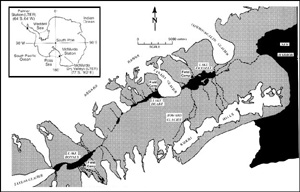
Above: McMurdo Dry Valleys long-term ecological research
area.
The objectives of the McMurdo Dry Valleys LTER are to understand
the influence of physical and biological constraints on the structure
and function of dry valley ecosystems and to understand the modifying
effects of material transport on these ecosystems. The McMurdo Dry
Valley ecosystems are driven by the same basic processes — such
as microbial use and re-mineralization of nutrients — found in
all ecosystems, but lack many confounding variables — such as
higher plants and animals — found in other ecosystems. McMurdo
Dry Valleys LTER research contributes
to general ecological understanding through studies of processes that
are readily resolved in these ecosystems. To successfully accomplish
these studies requires that scientists be present in
the McMurdo Dry Valleys. Samples and measurements cannot be obtained
remotely and experiments must be conducted on site if they are to have
any relevance to the environment.
In its January 1997
report, the McMurdo LTER's Site Review Committee wrote “the McMurdo
LTER project is working on an incredible system for ecological study.
It
is not just an unique area, but more importantly, it exists at one
end of the arid and cold spectra of terrestrial ecosystems.” All
ecosystems are dependent upon liquid water and shaped to varying degrees
by climate
and material transport, but nowhere is this more apparent than in the
McMurdo Dry Valleys. In very few places on this planet are there environments
where minor changes in climate so dramatically affect the capabilities
of organisms to grow and reproduce. Indeed, the data being collected
by the LTER indicate that the Dry Valley's are very sensitive to small
variations in solar radiation and temperature, and that this site may
well be an important natural regional-scale laboratory for studying
responses to human alterations of climate. While the antarctic ice
sheets respond to climate change on the order of thousands of years,
the glaciers, streams, and ice-covered lakes in the McMurdo Dry Valleys
respond to change almost immediately. Thus, it is in the McMurdo Dry
Valleys that the first effects of climate change in Antarctica may
be observed.
|